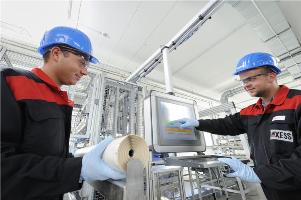Engineers at Fraunhofer have collaborated with specialty chemicals manufacturer LANXESS to simultaneously design and develop a system for manufacturing membrane elements used in reverse osmosis of water by employing virtual engineering.
 Membrane Element Produced at the Semi-automatic facility of LANXESS
Membrane Element Produced at the Semi-automatic facility of LANXESS
The innovation is the result of LANXESS’ decision to enter the business of water treatment. With rising global population, the existing 0.3% of potable water from the world’s water resources is insufficient. The continuous need for clean water has resulted in the growth of water treatment technologies, particularly, reverse osmosis in which a membrane filter is employed to eliminate virus, bacteria, pesticides and salts from the water. In 2010, LANXESS wanted to build a sophisticated manufacturing facility for membrane elements by the fall of 2011 at a site in Bitterfield that was the location of one of its subsidiaries. The ambitious timeline meant that both manufacturing technology and the product had to be developed simultaneously. LANXESS approached the Fraunhofer Institute for Factory Operation and Automation.
Both the teams used computer aided simulations to analyze the yet to be developed product features and determine the critical manufacture parameters. This way, the semi-automatic system comprising the virtual models was used to devise and optimize the process steps. The system also enabled resource estimation. Another significant development was the special technique devised to enable the programming of a control system based on the virtual model. Control systems are usually programmed when the manufacturing system is set up which makes it extremely difficult to make changes. This innovative method allowed the team to check for errors and make changes even before the system was built. Membrane element production began last year at Bitterfield. Fraunhofer engineers are working on fully automating the facility.